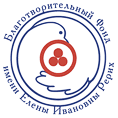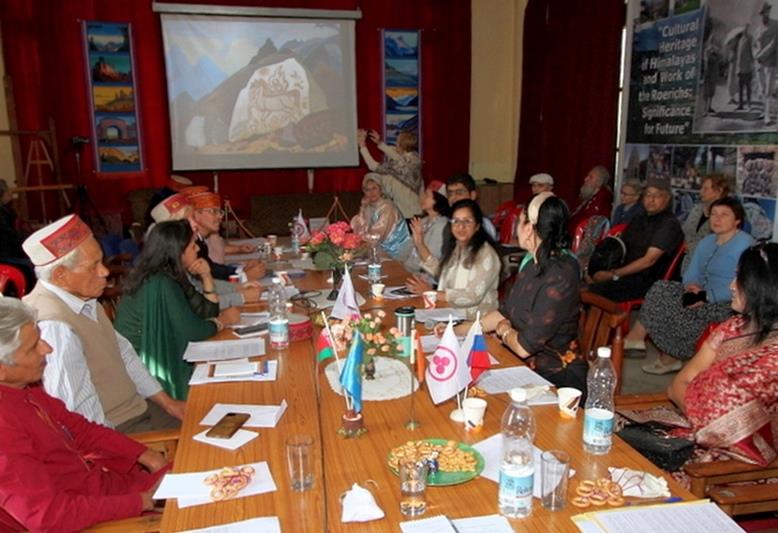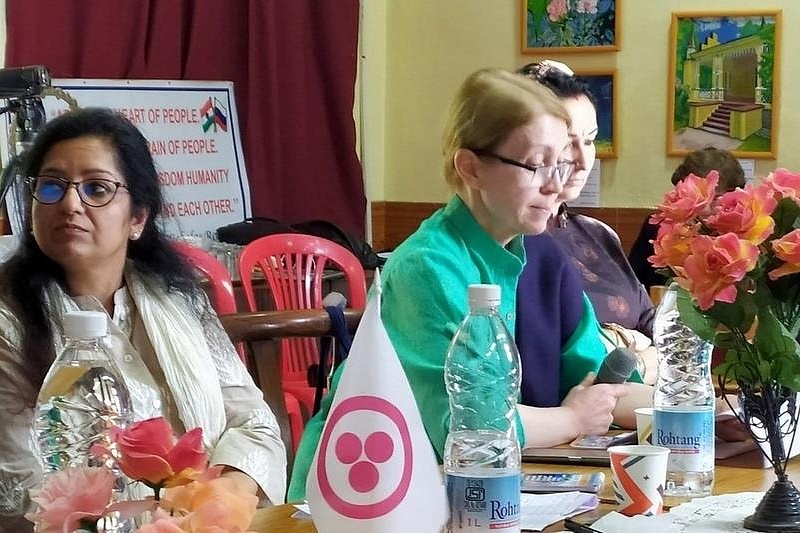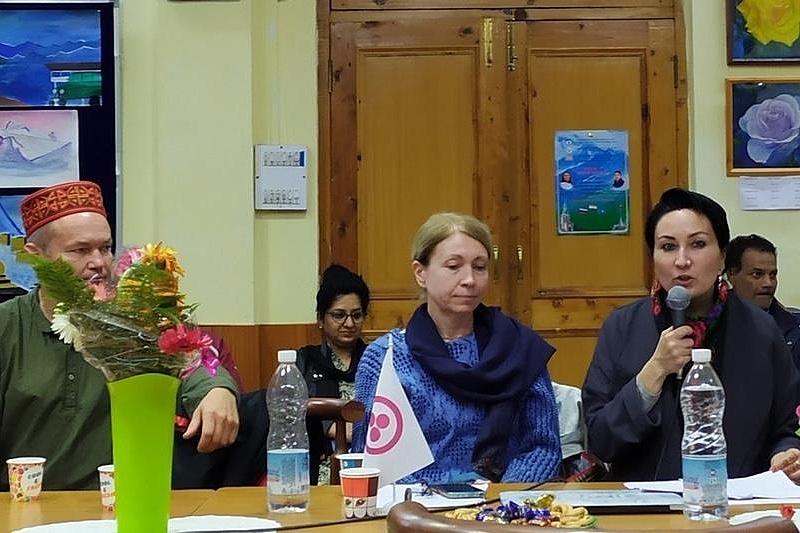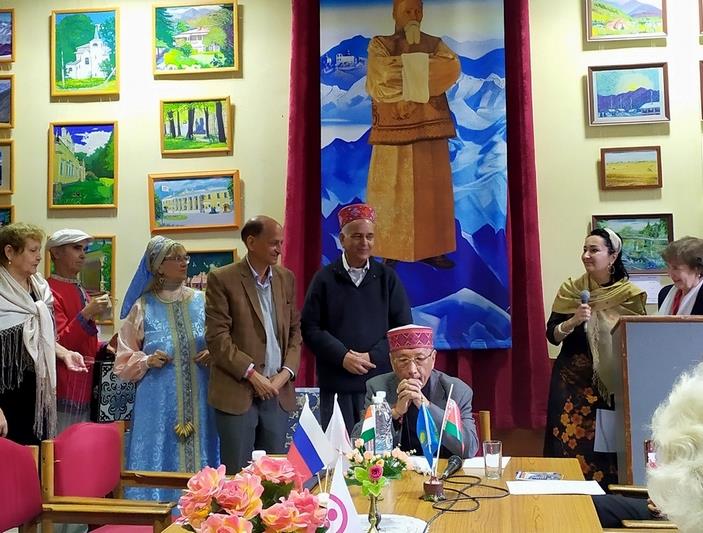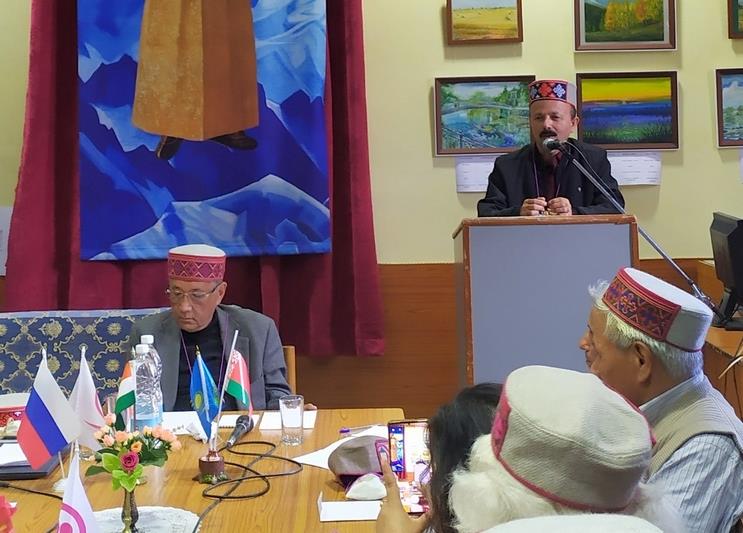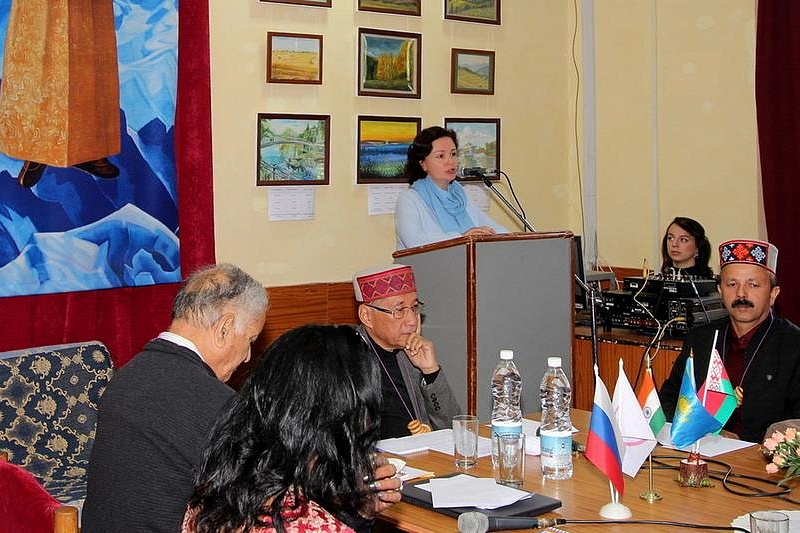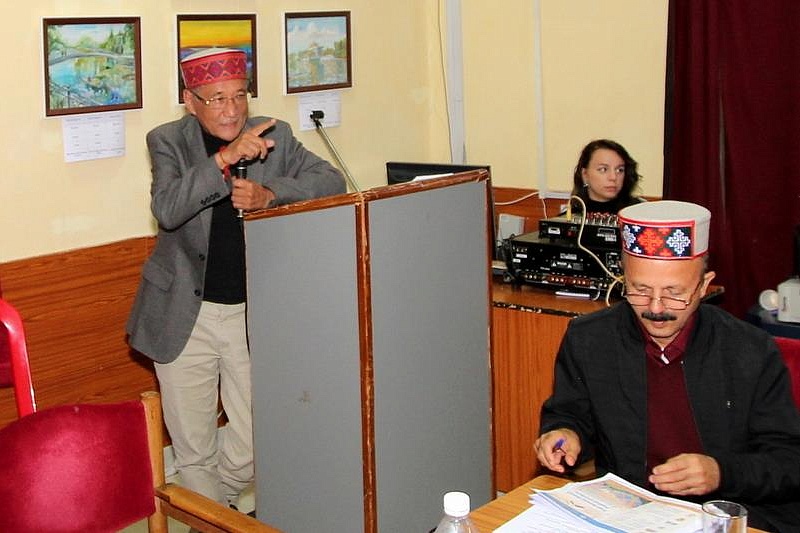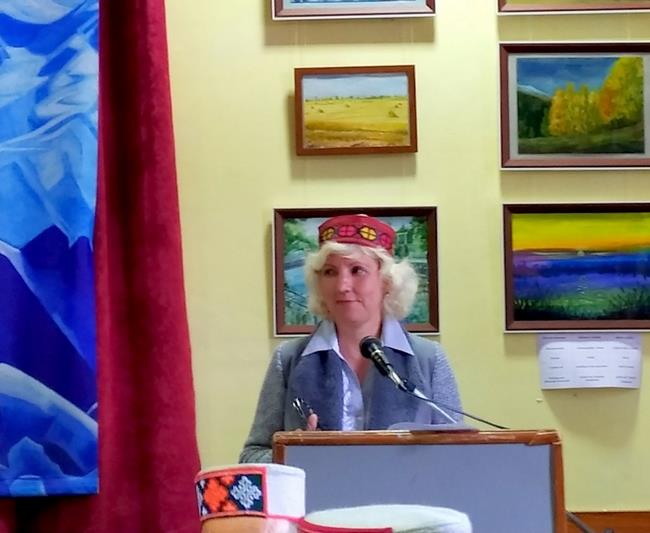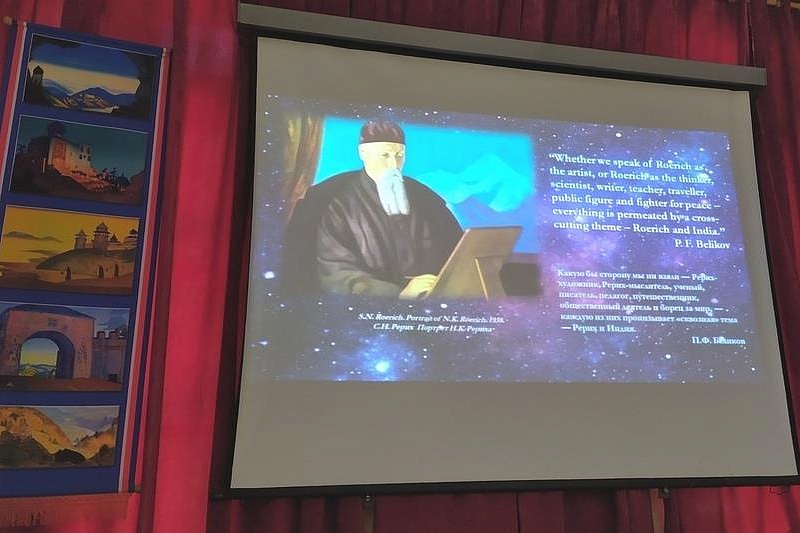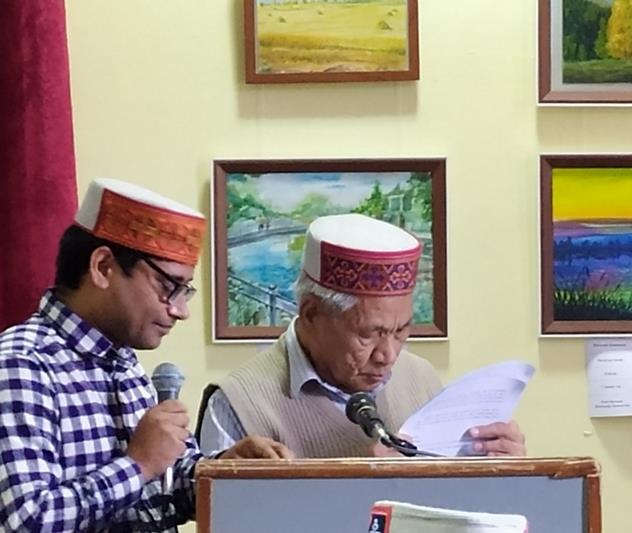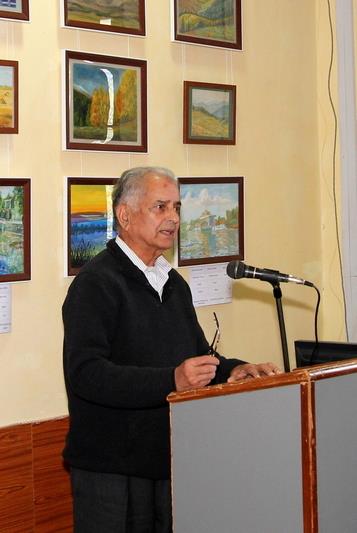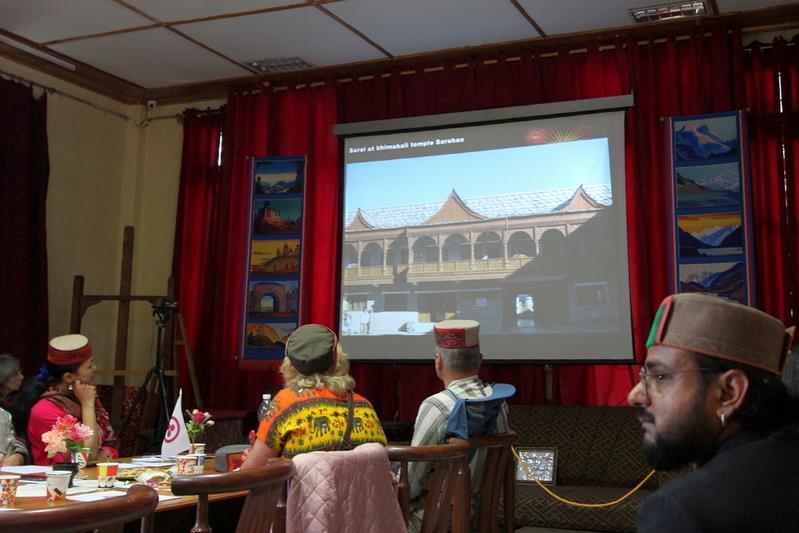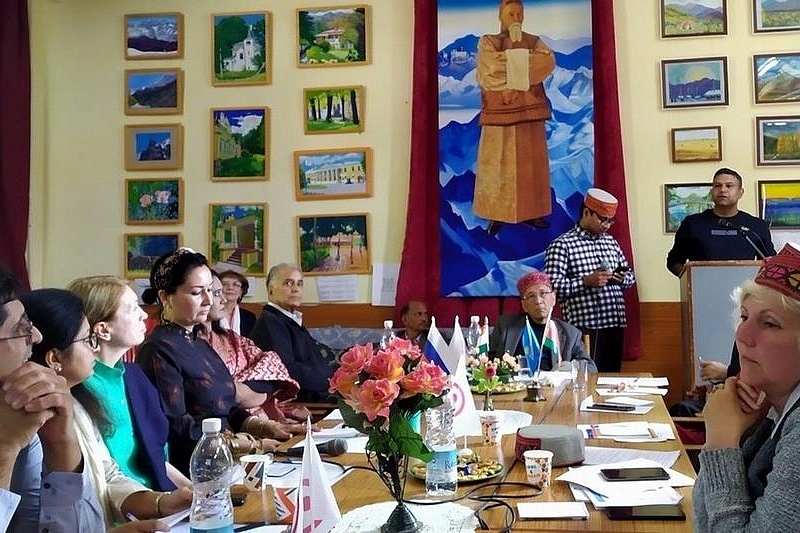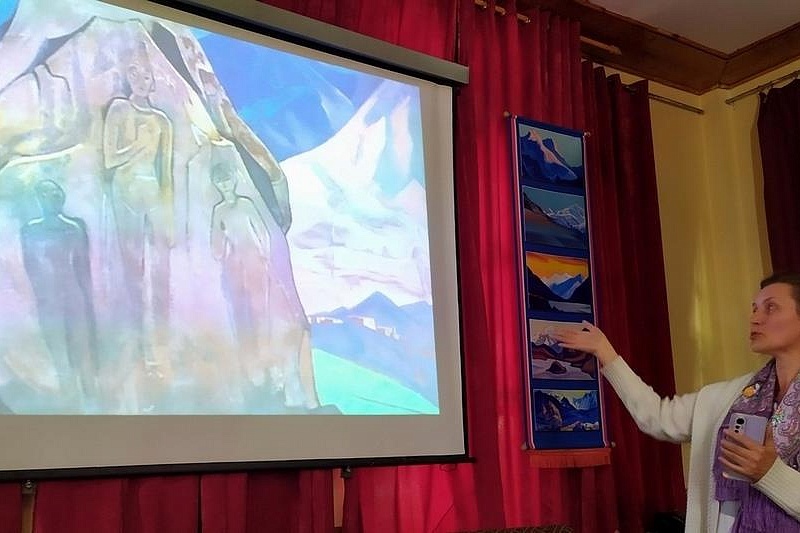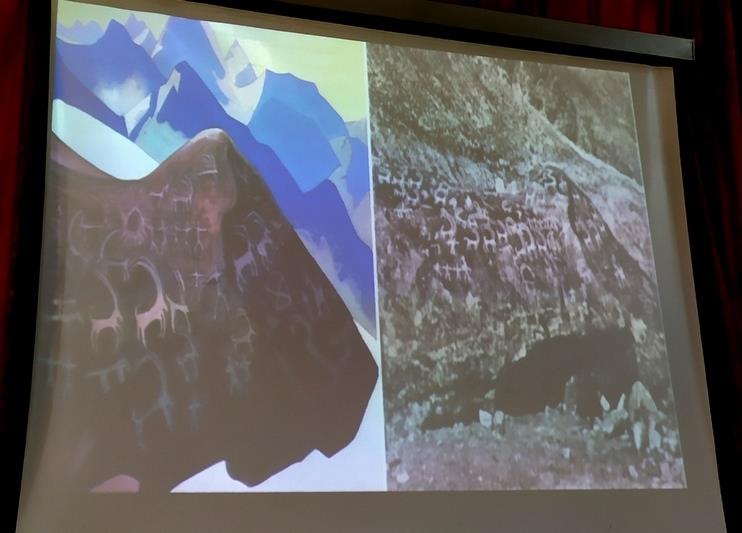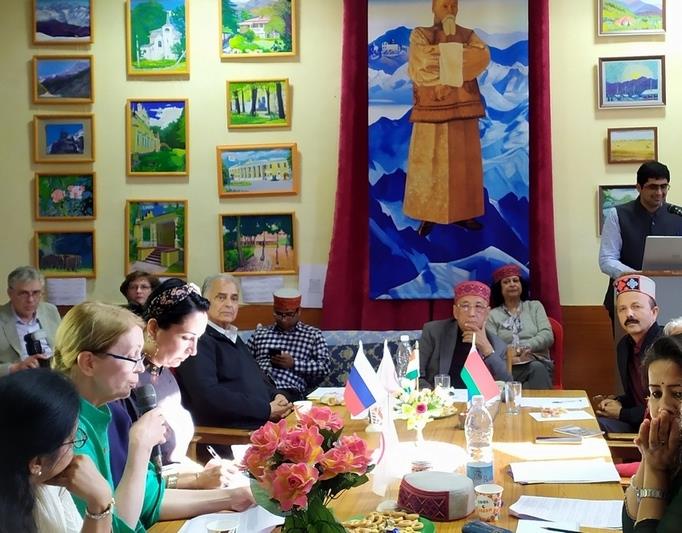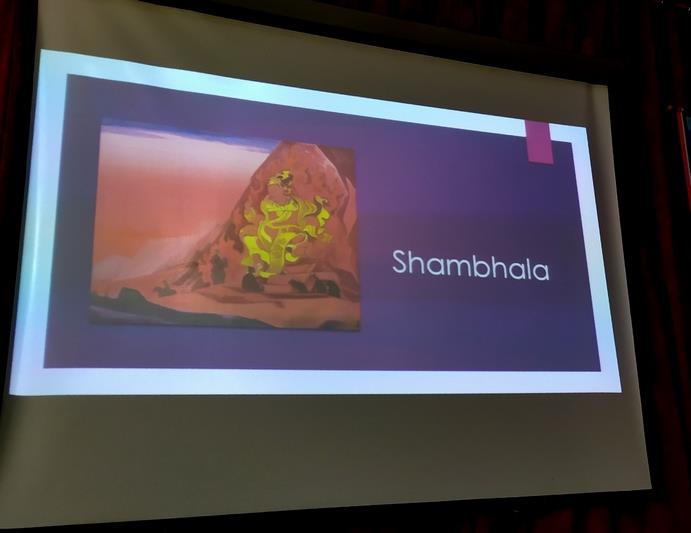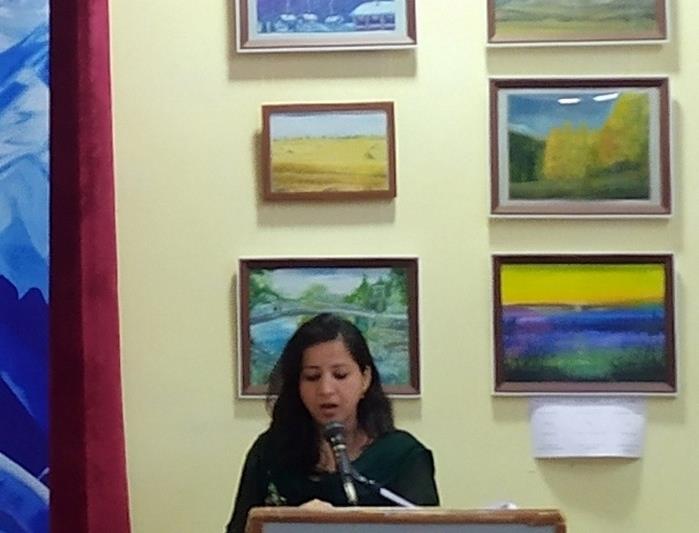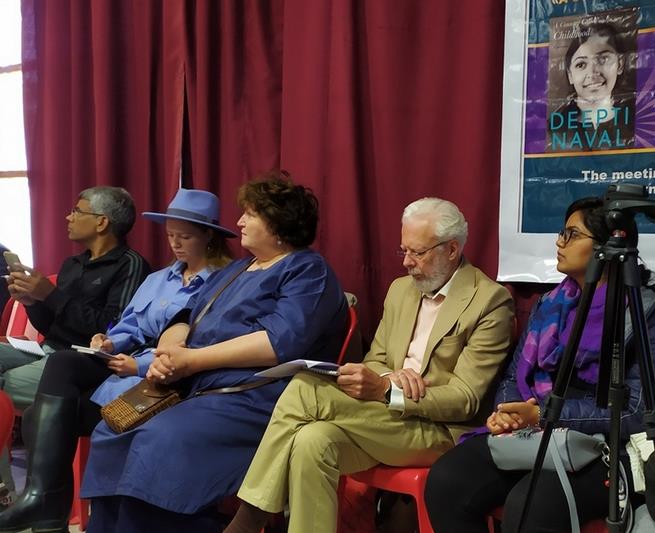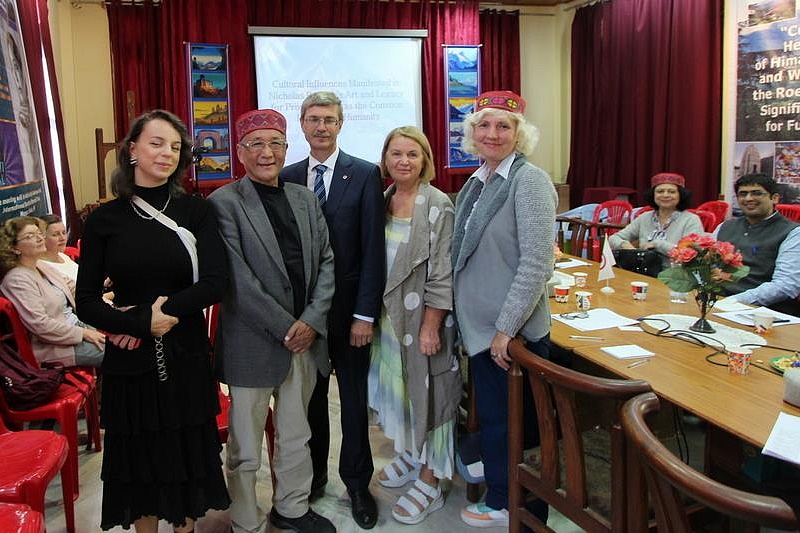International Conference in the IRMT “Cultural Heritage of Himalayas and Work of the Roerichs: Significance for Future”. Day One
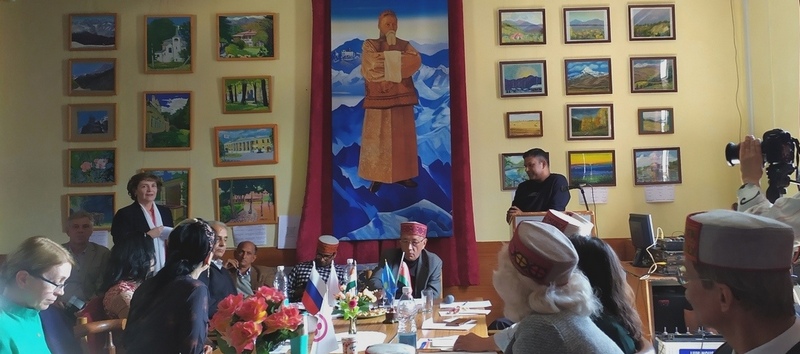
|
On October 10–11, 2022 within the framework of the October Roerich Festival of Culture at the International Roerich Memorial Trust the International Scientific Conference “Cultural Heritage of Himalayas and Work of the Roerichs: Significance for Future” took place. The Conference was organized by the Himachal State Museum (Shimla, India) in cooperation with the International Roerich Memorial Trust, the International Center of the Roerichs (Moscow, Russia), and “Faraon” Historic Films Studio (St. Petersburg, Russia).
The Conference was held in the face-to-face format. Eighteen papers and presentations in English and Russian were presented by scholars and researchers from India, Russia, and Kazakhstan. The moderators of the Conference were Olga Karaseva, research worker of the United Scientific Center for Cosmic Thinking Problems of the International Center of the Roerichs (Moscow, Russia), PhD scholar, Jawaharlal Nehru University (New Delhi) and Vikas Banual, researcher and conservator at the Himachal State Museum (Shimla, India). The translation from English into Russian and back was done by Olga Karaseva (she is the Conference moderator), Elena Ivanko, English teacher, translator of Sufi poetry (Russia – Vrindavan, India) and Gautam Kashyap, researcher and translator (Bihar, India), graduate of St. Petersburg State University (Russia).
Mr. Ashok Thakur, the lifetime Trustee of the IRMT, Ms. Yulia Aryaeva, Head of the Cultural Department of the Russian Embassy in India and Mr. Hari Chauhan, Curator of the Himachal State Museum, Shimla were the honored guests of the Conference.
The Conference was opened by Mrs Larisa Surgina, the Russian Curator of the IRMT, working in the Trust under the agreement of cooperation between the IRMT (India) and the ICR (Russia) and Mr Suresh Kumar, the Indian Curator of the IRMT. They noted that the main purpose of the Conference is to bring together scholars and researchers involved in the study of Himalayan culture and the work of the Roerich family and to provide them with a platform for interested discussions on the relevance of the Himalayan cultural heritage and the Roerichs creative work. For the Roerich family, the Himalayas have always been a reservoir of the ancient thought, beauty and wisdom. The most ancient cultural traditions are preserved and continue to live on in the Himalayas, as if in a vast open-air museum. This richness makes the Himalayas a treasure trove of all kinds of human achievements, the significance of which for the future is difficult to overestimate.
Dr. Hari Chauhan addressed the audience with a welcoming speech. The Curator of the Himachal Pradesh Museum recalled how ten years ago he first came to the International Roerich Memorial Trust to document the Roerichs heritage (note: this work was carried out in collaboration with a group of museum experts from the International Center of the Roerichs, Moscow). Dr. Chauhan was so impressed by the extensive knowledge and creative work of Nicholas Roerich and the work being done at the Trust that he found it necessary to continue the collaboration between the Museum in Shimla and the Roerich Trust in Naggar. This year, the Curator of the Shimla Museum approached the management of the IRMT and the Russian and Indian Curators with a proposal to organize an international seminar/conference where we could come together and discuss the achievements of the Roerichs and their invaluable contribution to Himalayan culture as well as other aspects of Himalayan cultural heritage. Dr. Chauhan expressed his hope and confidence that all that will be discussed at the Conference will constitute an important chapter in the history of Himalayan culture and noted that the work of the Roerichs has a timeless significance for the future.
The representative of the Russian Embassy Mrs Yulia Aryaeva reminded of the importance of one of the most important acts of Nicholas Roerich – the Roerich Pact, the first international treaty for the protection of cultural values, whose ideas are the basis for mutual understanding between peoples, for building a new, fair world.
Mr Ashok Thakur, a member of the Board of Trustees of the Roerich Trust, expressed his approval of the fruitful cooperation between the Museum in Shimla and the Roerich Trust. He noted that Nicholas Roerich's thoughts and ideas were far ahead of their time, and it is very important that the Conference participants and guests gathered in this room today to discuss and carry to the world the ideas of the Roerichs and, in particular, the ideas of the Roerich Pact.
The practical part of the Conference was opened with the report of Dr. Lubov Khomenok, Head of the Development Department of the International Center of the Roerichs (Moscow) on “Spiritual Treasures of the Himalayas in the Artistic Work of Nicholas Roerich”. The speaker noted that the ancient rich culture of India had a great influence on the works of Nicholas Roerich. India appeared in the paintings of the Russian artist as early as in 1905. In 1923, when Roerich first set foot on the land of India and finally saw the Himalayas, their majestic peaks became the main source of inspiration for thousands of Roerich's paintings. For Roerich the Himalayas are associated with the names of the greatest ascetics: rishis, arhats, yogis, sages. In Nicholas Roerich's paintings we recognize the famous hero Arjuna, divine Krishna, spiritual ascetic Ramakrishna, healer Charaka, Lord Buddha himself and his great followers. For Nicholas Roerich they are all Spiritual Teachers who enriched the world with new evolutionary knowledge. Roerich believed that the precious pearls of the past, present and future need to be firmly connected by the silver thread of the true religious connection with the Supreme, which is the basis of all Indian culture. When this happens, then the Satya Yuga, the Age of Light, will come. Nicholas Roerich gives insight into this light vector of the future development of people.
Mr. Tobdan, an independent researcher and writer (Himachal Pradesh, India) spoke on “Nicholas Roerich, the Great Artist, and His Love for Kullu and Lahul in the Himalayas”. He noted that Nicholas Roerich was a great admirer of the Himalayas, of which he knew from his early age. In the Himalayas, the Roerichs settled in the Kullu Valley, to which the artist dedicated many admiring lines. He wrote about the ancient culture of the valley, about the rishis, sages and heroes whose memory the valley holds: Rishi Vyasa, Lord Buddha, Padma Sambhava. And of the three hundred and sixty gods who live in the Kullu valley. According to the preserved recollections, the Roerichs led a very simple life in Kullu, they helped local people, took a lively interest in traditional festivals and holidays. In his painting pursuits, Roerich visited higher places in the Himalayas, and one of his favorite places of work was Lahul. The speaker noted that in the Tibetan tradition, Roerich is seen as an incarnation of the Fifth Dalai Lama.
The presentation by Dr. O.C.Handa, a renowned scholar, writer, and author of 47 books on Indian history, art, and culture was titled “Traditional Domestic Architecture of Himachal Pradesh”. Dr. Handa spoke about some of the types of traditional houses and temples that are characteristic of the various mountain regions of the state. He pointed out that the biophysical and ethno-cultural conditions of the regions as well as the occupational customs therein determine the choice of building materials, layout parameters and organization of space in the traditional structures. For example, in the Kyarda Doon Valley the most traditional peasant houses are built of wood, bamboo, and straw, and the walls and floors of these houses are decorated with rich artistic paintings. On the other hand, in the wooden architecture of the Middle Himalayan regions, the exposed wooden structures are abundantly decorated with carvings, which gives the houses a very beautiful appearance. In the lowland areas, houses built of stone are common. And the Khash domestic architecture in the eastern Himachal State is a separate type due to its distinctive features characterized by wooden construction, perfect windows, doors etc. made without nails, high pitched roofs etc. Thus all the old houses look very organic in their natural environment and are characterized by beauty and practicality. They are part of the cultural heritage of the Himalayas and require special care.
“Himalayan Heritage as reflected in Roerich's Paintings” was the title of the paper prepared by Mr Vikas Banual, researcher and conservator of the Himachal State Museum, in collaboration with Dr. Hari Chauhan, Curator of the Museum. While conducting archaeological and ethnographic research in the Himalayas, the authors of the report drew attention to the ancient rock carvings and bas-reliefs found in various regions such as Lahul and Spiti. They analogized the preserved images with similar images in the paintings of Nicholas Roerich and concluded that the artist's paintings were based on real monuments of the cultural heritage of the Himalayas. Roerich saw them, studied them and captured them very accurately in his paintings, endowing them at the same time with deep historical, cultural and spiritual meaning and significance.
Mrs. Lavlin Thadani, Ph.D. in Russian Literature from the Moscow State University, a former lecturer at JNU and Chairperson of Muskan Production Media House (New Delhi) presented her perspective on “Cultural Influences Manifested in Nicholas Roerich’s Art, and Legacy for Promoting Art as the Common Heritage of Humanity”. The presentation focused on the importance of Roerich's paintings in shaping the spiritual consciousness of the individual, based on reverence for nature and unity with it. Living in India, studying and absorbing the best of its natural and cultural heritage, Roerich praised the value of different cultures and promoted the spirit of intercultural interaction. The basis of philosophical worldview of his paintings is the idea of divinity as the fundamental principle of all creation.
The presentation by Mrs Natalia Kravchenko (Tavricheskaya Academy, Department of Cultural Studies, Crimea, Russia – National Gallery of Modern Art, New Delhi), who unfortunately could not personally attend the Conference, was entitled “The Himalayan Journey: Nicholas Roerich and Bireswar Sen”. The report noted that Nicholas Roerich's art and his creative heritage have had an indelible influence on generations of Indian artists and intellectuals. Dr. Kalidas Nag described Roerich as “the first Russian ambassador of Beauty, who brought to India the immortal message of art”. Bireswar Sen was among the Indian artists who were influenced by Roerich's peculiar style and his vision of the Himalayas as a sacred place. In 1932 he visited the studio of Nicholas Roerich in Naggar and his meeting with the famous Russian artist changed his life in many ways. He devoted his talent exclusively to the glory of the Himalayas, which became his spiritual home. For many years the two artists kept relationship and cultural cooperation.
Mrs. Harsh Inder Loomba, Senior Researcher Fellow, Ministry of Culture, Government of India, Visual artist, Scholar (New Delhi) presented her paper “Roerich – Pillar of Art, Culture and Heritage”. She drew attention to the universal synthesis that was characteristic of Nicholas Roerich and helped solve the most difficult issues. Roerich always emphasized the most positive, creative foundations. With his profound understanding of the future development of society, Roerich proclaimed the concept of beauty, peace and knowledge. Roerich's paintings contain the key to many questions that arise for every thinking person. The artist left messages for the future generations in them. With his profound knowledge and insight, Roerich earned from the Indians the supreme title, Maharishi, and this is not just gratitude, but recognition of his achievement of the supreme knowledge that was bestowed upon him. His paintings are a window into that Higher World of which we are unaware, and a desire to show us our possibilities. The significance of Roerich's work for the future is immense.
Dr. Dev Kanya Kakur, a filmmaker and writer from Himachal, concluded by addressing the audience. She raised the burning issue of women's inequality and the need for urgent solutions at the state government level to alleviate the plight of women and ensure their rights. The Roerichs wrote extensively that equality and cooperation between men and women is one of the basic laws of the cosmos. Many distortions in human history have to do with the unjust treatment of women. As Helena Roerich wrote, the bird of humanity cannot fly on one wing. Mr. Ashok Thakur, the guest of honor at the Conference, who has extensive administrative experience, promised to assist Dev Kanye Kakur in addressing the issues she raised.
The first day of the Conference ended with questions and answers, a lively exchange of views, and a vigorous photo shoot.

